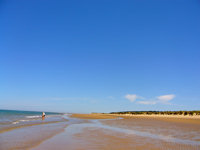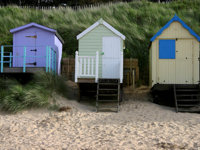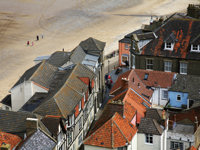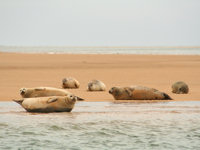Insider's guide to the Norfolk coast
For staycationers, the wide, open spaces of East Anglia have an incredible attraction: not too much travelling, but a real get-away-from-it-all atmosphere. In Norfolk, mile after mile of beaches sweep round the coast and vast nature reserves hug the shore, with pretty flint villages just inland. But the downside is that it just keeps on getting more popular. Long-time local resident Rowan Jones gives her insider tips on how to get the best out of the Norfolk coast without getting stuck in traffic or swamped by crowds.
The extreme northwest tip of Norfolk might seem a remote landscape of dunes and marshes, studded with windmills and sturdy flint cottages, but parts of it have been so comprehensively “discovered” by visitors that Burnham Market is dubbed Chelsea-on-Sea by locals. It’s packed with pretty, trendy shops and eateries, (and beautiful, boaty people).
Insider tip: For a taste of the atmosphere, but without the traffic, try Creake Abbey Studios, just a couple of miles further inland. It’s a working farm, ruined abbey and courtyard of low flint barns housing an art gallery, spa treatment rooms, a monthly farmers’ market, art and craft workshops, and shops selling hand-made cushions, impossibly cute kids’ clothing and distressed garden accoutrements. And the charming Creakey Café serves breakfasts, lunches and teas. Its cakes and coffee, or cream teas, eaten from Cath Kidston crockery, are memorable. On the coast, Brancaster is deservedly popular, but it’s easy to escape the crowds, even in high summer.
 Norfolk's beaches can stretch for miles
Norfolk's beaches can stretch for milesHemera
To the west is Holme, at the end of a Roman road from distant Essex. Here the beach is so vast that most of Essex could probably invade and there would still be space. Although it’s an area with a story attached. This was the spot where, 4,000 years ago, a huge oak tree was felled, dragged into place using ropes of twisted honeysuckle stems, and upended. More oaks created a circular temple, where dead bodies were placed on a tree-trunk altar, to be picked clean by birds. The temple was eventually covered by the sea – and only rediscovered in 1999.
Insider tip: It was dubbed Seahenge and today the sands and tides have obliterated any trace of it at Holme, but its timbers were removed and preserved and are on display in King’s Lynn Museum. And the cries of the birds still echo over the wild dunes of Holme. Travelling eastwards, the coast road is studded with places to try local seafood delicacies. Samphire grows wild, or buy a bag at one of the many roadside stalls.
At idyllic Burnham Overy Staithe the shape-shifting dunes and marshes of Scolt Head Island are linked, at low tide, to the mainland by an unmarked path winding through samphire and creek channels. But visitors should wait for the high-season, high-tide, ferry, as the ever-changing channels and currents and tidal flows of mingled river and sea can be deadly. The uninhabited island is four miles long, but much less across its spine from landward saltmarsh to sea-facing sand dune. On a sunny day it can be a desert island paradise of glittering white sand and blue ocean where you can soon be completely alone to picnic in the hollow of a dune, or marvel at the wildlife.
 Pretty beach huts decorate the coast
Pretty beach huts decorate the coastIstockphoto/Thinkstock
Just east of Burnham Overy Staithe there is a layby where people park and walk the half-mile to Gun Hill – a wilderness of high dunes spilling down to a white-sand beach, with views back to Scolt Head Island and on to Holkham bay.
Insider tip: There are all kinds of ways of experiencing the wildlife of Norfolk. If binoculars and birding books are not your thing, then how about alongside an alpaca? Just east of the pretty harbour town of Wells (it’s beach huts are iconic) the terminus of the Walsingham to Wells narrow gauge railway (itself a delight) are a small herd of alpacas you can book out for treks along the coast path.
Both Blakeney and Cley are crammed with impossibly pretty flint cottages. Boats bob along the staithes or take tourists out to marvel at the seals. Art galleries, delis and tearooms are testament to a rather upmarket tourist charm. At Cley a huge wildlife reserve is beloved by bird-watchers from across Britain (and birds migrating birds from as far as Africa and the Arctic).
A couple of miles inland, a tiny museum beside a river ford, is devoted to shells. The Glandford Shell Museum is quaint, quirky and shows off some beautiful shells – as well as allowing fossils and pottery some shelf space too. Continue eastwards from busy Blakeney and Cley, to Salthouse which also has flint and seafood and art (its summer church contemporary art exhibition is a fixture of the north Norfolk calendar.)
Insider tip: Cookies Crab Shop has been going half a century and its vast plates of crayfish, lobster, crab, mackerel, herring, samphire and salad are an institution. Tables are crammed into its tiny general store, and a courtyard shed and gazebo, and out facing the green and the sea. Take your own wine or buy cloudy Norfolk apple juice to wash down fishy feasts which cost less than a tenner. Booking ahead is advised (tel: 01263 740352).
 Plenty of room on the beach
Plenty of room on the beachIstockphoto/Thinkstock
Insider tip: To escape the crowds, take the cliff path out of Cromer, past the lighthouse, to the tiny seaside village of Overstrand. Its unpretentious Cliff Top Café is a great place to refuel before the walk back.
 Lucky visitors might spot some seals
Lucky visitors might spot some sealsIstockphoto/Thinkstock
The entire coast is swathed in sand, so almost every village has its own beach. But each will have its own usp too. At Waxham, one of the biggest medieval barns in the country has been turned into a tea room and on a hot summer’s day the cool stone interior of the ancient thatched complex is pleasant retreat from hot sands. There are often seals swimming just off shore here.
Glitzy, teeming, amusement-arcaded Great Yarmouth comes almost at the end of this arc around Norfolk’s coast. But there is more to Yarmouth than candyfloss and fairground rides. Britain’s only complete circus building stands a street back from the seafront. The Hippodrome is more than 100 years old and still hosts world-class circus shows – and has an extraordinary extra trick of its own. As the finale of a show approaches the floor slides away, fountains soar, water gushes in, and the circus ring becomes a swimming pool. Just along the sea-front the Pleasure Beach rides range from family fairground fun to white-knuckle stuff, but its crowning glory is the wooden roller coaster – complete with a brake-man who rides every train, making each roll of the coaster unique.
Insider tip: Everyone knows Nelson’s Column in London, but there is another in Great Yarmouth – and you can climb this one to earn stunning views of dunes, marshes, townscape and sea, inland windmills and drainage pumps and platoons of glittering off-shore wind turbines.
AND STEER CLEAR OF…
• Driving on the A149 coast road where it narrows to navigate villages, so head inland to pretty villages such as Wiveton.
• If the buzz of jet skis is not your thing, then Sea Palling beach is one to avoid.
• Travelling on a Saturday when the few main roads can be packed with caravans and cars.
Do you have any Feedback about this page?
© 2025 Columbus Travel Media Ltd. All rights reserved. No part of this site may be reproduced without our written permission, click here for information on Columbus Content Solutions.









 You know where
You know where